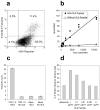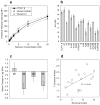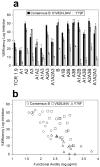Fine-tuning of T-cell receptor avidity to increase HIV epitope variant recognition by cytotoxic T lymphocytes
- PMID: 20881472
- PMCID: PMC2997528
- DOI: 10.1097/QAD.0b013e32833f7b22
Fine-tuning of T-cell receptor avidity to increase HIV epitope variant recognition by cytotoxic T lymphocytes
Abstract
Objective: T-cell receptor (TCR) gene therapy is an approach being considered for HIV-1, but epitope mutation is a significant barrier. We assessed whether HIV-specific TCR can be modified to have broader coverage of epitope variants by recombining polymorphisms between public clonotype TCR sequences.
Design: Public clonotype TCRs recognizing the same epitope often differ by polymorphisms in their third complementarity determining regions (CDR3). We assessed whether novel combinations of such polymorphisms could improve TCR recognition of epitope variation.
Methods: A TCR recognizing the HLA A*0201-restricted epitope SLYNTVATL (Gag 77-85, SL9) was engineered to have combinations of four polymorphisms in the CDR3 regions compared to another SL9-specific TCR. These novel TCRs were screened for functional avidities against SL9 epitope variants and abilities to mediate cytotoxic T-lymphocyte suppression of HIV-1 containing the same epitope variants.
Results: The TCRs varied modestly in functional avidities for SL9 variants, due to alterations in affinity. This translated to differences in antiviral activities against HIV-1 when functional avidity changes crossed the previously defined threshold required for efficient recognition of HIV-1-infected cells. Higher avidity TCR mutants had generally broader recognition of SL9 variants.
Conclusion: These results indicate that rationally targeted increases in functional avidities can be utilized to maximize the antiviral breadth of transgenic TCRs. In contrast to previously reported random mutagenesis to markedly increase functional avidities, tuning through recombining naturally occurring polymorphisms may offer a more physiologic approach that minimizes the risk of deleterious TCR reactivities.
Figures




Similar articles
-
The HIV-1 HLA-A2-SLYNTVATL is a help-independent CTL epitope.J Immunol. 2004 May 1;172(9):5249-61. doi: 10.4049/jimmunol.172.9.5249. J Immunol. 2004. PMID: 15100263
-
Degeneracy and repertoire of the human HIV-1 Gag p17(77-85) CTL response.J Immunol. 2006 Jun 1;176(11):6690-701. doi: 10.4049/jimmunol.176.11.6690. J Immunol. 2006. PMID: 16709828
-
Recognition patterns of HLA-A2-restricted human immunodeficiency virus-1-specific cytotoxic T-lymphocytes in a cohort of HIV-1-infected individuals.Viral Immunol. 2005;18(4):627-36. doi: 10.1089/vim.2005.18.627. Viral Immunol. 2005. PMID: 16359229
-
Efficient processing of the immunodominant, HLA-A*0201-restricted human immunodeficiency virus type 1 cytotoxic T-lymphocyte epitope despite multiple variations in the epitope flanking sequences.J Virol. 1999 Dec;73(12):10191-8. doi: 10.1128/JVI.73.12.10191-10198.1999. J Virol. 1999. PMID: 10559335 Free PMC article.
-
Co-Receptor CD8-Mediated Modulation of T-Cell Receptor Functional Sensitivity and Epitope Recognition Degeneracy.Front Immunol. 2013 Oct 21;4:329. doi: 10.3389/fimmu.2013.00329. Front Immunol. 2013. PMID: 24151493 Free PMC article. Review.
Cited by
-
Generation of β cell-specific human cytotoxic T cells by lentiviral transduction and their survival in immunodeficient human leucocyte antigen-transgenic mice.Clin Exp Immunol. 2015 Mar;179(3):398-413. doi: 10.1111/cei.12465. Clin Exp Immunol. 2015. PMID: 25302633 Free PMC article.
-
HIV-1 epitopes presented by MHC class I types associated with superior immune containment of viremia have highly constrained fitness landscapes.PLoS Pathog. 2017 Aug 7;13(8):e1006541. doi: 10.1371/journal.ppat.1006541. eCollection 2017 Aug. PLoS Pathog. 2017. PMID: 28787455 Free PMC article.
-
HIV-1-Specific Chimeric Antigen Receptors Based on Broadly Neutralizing Antibodies.J Virol. 2016 Jul 11;90(15):6999-7006. doi: 10.1128/JVI.00805-16. Print 2016 Aug 1. J Virol. 2016. PMID: 27226366 Free PMC article.
-
CTL responses of high functional avidity and broad variant cross-reactivity are associated with HIV control.PLoS One. 2012;7(1):e29717. doi: 10.1371/journal.pone.0029717. Epub 2012 Jan 4. PLoS One. 2012. PMID: 22238642 Free PMC article.
-
TCR affinity associated with functional differences between dominant and subdominant SIV epitope-specific CD8+ T cells in Mamu-A*01+ rhesus monkeys.PLoS Pathog. 2014 Apr 17;10(4):e1004069. doi: 10.1371/journal.ppat.1004069. eCollection 2014 Apr. PLoS Pathog. 2014. PMID: 24743648 Free PMC article.
References
-
- Riddell SR, Greenberg PD. T cell therapy of human CMV and EBV infection in immunocompromised hosts. Rev Med Virol. 1997;7:181–192. - PubMed
-
- Yang OO. CTL ontogeny and viral escape: implications for HIV-1 vaccine design. Trends Immunol. 2004;25:138–142. - PubMed
-
- Perelson AS, Essunger P, Ho DD. Dynamics of HIV-1 and CD4+ lymphocytes in vivo. Aids. 1997;11(Suppl A):S17–24. - PubMed
Publication types
MeSH terms
Substances
Grants and funding
LinkOut - more resources
Full Text Sources
Other Literature Sources
Research Materials

